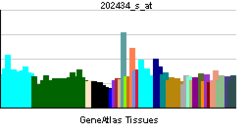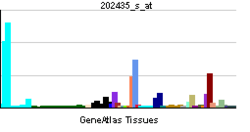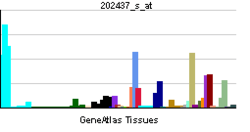CYP1B1
| View/Edit Human | View/Edit Mouse |
Cytochrome P450 1B1 is an enzyme that in humans is encoded by the CYP1B1 gene.[4]
Function
CYP1B1 belongs to the cytochrome P450 superfamily of enzymes. The cytochrome P450 proteins are monooxygenases which catalyze many reactions involved in drug metabolism and synthesis of cholesterol, steroids, and other lipids. The enzyme encoded by this gene localizes to the endoplasmic reticulum (ER) and metabolizes procarcinogens such as polycyclic aromatic hydrocarbons and 17beta-estradiol.
Despite over 20 years of research on CYP1A1 and CYP1A2, CYP1B1 was not identified and sequenced until 1994. Nucleic and amino acid analysis showed approximately 40% identity with CYP1A1. Despite this similarity, these two enzymes have very different catalytic efficiencies and metabolites when incubated with common substrates, such as retinoic acid and arachidonic acid. Recently CYP1B1 has been shown to be physiologically important in fetal development, since mutations in CYP1B1 are linked with a form of primary congenital glaucoma.
CYP1A1 and CYP1B1 are regulated by the aryl hydrocarbon receptor, a ligand activated transcription factor. They are part of the Phase I reactions of drug metabolism.
Clinical significance
Mutations in this gene have been associated with primary congenital glaucoma; therefore it is thought that the enzyme also metabolizes a signaling molecule involved in eye development, possibly a steroid.[4]
References
Further reading
- Smith G, Stubbins MJ, Harries LW, Wolf CR (1999). "Molecular genetics of the human cytochrome P450 monooxygenase superfamily.". Xenobiotica. 28 (12): 1129–65. doi:10.1080/004982598238868. PMID 9890157.
- Sasaki M, Kaneuchi M, Fujimoto S, et al. (2004). "CYP1B1 gene in endometrial cancer.". Mol. Cell. Endocrinol. 202 (1-2): 171–6. doi:10.1016/S0303-7207(03)00079-0. PMID 12770747.
- Nelson DR, Zeldin DC, Hoffman SM, et al. (2004). "Comparison of cytochrome P450 (CYP) genes from the mouse and human genomes, including nomenclature recommendations for genes, pseudogenes and alternative-splice variants.". Pharmacogenetics. 14 (1): 1–18. doi:10.1097/00008571-200401000-00001. PMID 15128046.
- Paracchini V, Raimondi S, Gram IT, et al. (2007). "Meta- and pooled analyses of the cytochrome P-450 1B1 Val432Leu polymorphism and breast cancer: a HuGE-GSEC review.". Am. J. Epidemiol. 165 (2): 115–25. doi:10.1093/aje/kwj365. PMID 17053044.
- Coca-Prados M, Escribano J (2007). "New perspectives in aqueous humor secretion and in glaucoma: the ciliary body as a multifunctional neuroendocrine gland.". Progress in retinal and eye research. 26 (3): 239–62. doi:10.1016/j.preteyeres.2007.01.002. PMID 17321191.
- Sutter TR, Guzman K, Dold KM, Greenlee WF (1991). "Targets for dioxin: genes for plasminogen activator inhibitor-2 and interleukin-1 beta.". Science. 254 (5030): 415–8. doi:10.1126/science.1925598. PMID 1925598.
- Sutter TR, Tang YM, Hayes CL, et al. (1994). "Complete cDNA sequence of a human dioxin-inducible mRNA identifies a new gene subfamily of cytochrome P450 that maps to chromosome 2.". J. Biol. Chem. 269 (18): 13092–9. PMID 8175734.
- Tang YM, Wo YY, Stewart J, et al. (1996). "Isolation and characterization of the human cytochrome P450 CYP1B1 gene.". J. Biol. Chem. 271 (45): 28324–30. doi:10.1074/jbc.271.45.28324. PMID 8910454.
- Stoilov I, Akarsu AN, Sarfarazi M (1997). "Identification of three different truncating mutations in cytochrome P4501B1 (CYP1B1) as the principal cause of primary congenital glaucoma (Buphthalmos) in families linked to the GLC3A locus on chromosome 2p21.". Hum. Mol. Genet. 6 (4): 641–7. doi:10.1093/hmg/6.4.641. PMID 9097971.
- Bejjani BA, Lewis RA, Tomey KF, et al. (1998). "Mutations in CYP1B1, the gene for cytochrome P4501B1, are the predominant cause of primary congenital glaucoma in Saudi Arabia.". Am. J. Hum. Genet. 62 (2): 325–33. doi:10.1086/301725. PMC 1376900
 . PMID 9463332.
. PMID 9463332. - Stoilov I, Akarsu AN, Alozie I, et al. (1998). "Sequence analysis and homology modeling suggest that primary congenital glaucoma on 2p21 results from mutations disrupting either the hinge region or the conserved core structures of cytochrome P4501B1.". Am. J. Hum. Genet. 62 (3): 573–84. doi:10.1086/301764. PMC 1376958
 . PMID 9497261.
. PMID 9497261. - Bailey LR, Roodi N, Dupont WD, Parl FF (1998). "Association of cytochrome P450 1B1 (CYP1B1) polymorphism with steroid receptor status in breast cancer.". Cancer Res. 58 (22): 5038–41. PMID 9823305.
- Plásilová M, Stoilov I, Sarfarazi M, et al. (1999). "Identification of a single ancestral CYP1B1 mutation in Slovak Gypsies (Roms) affected with primary congenital glaucoma.". J. Med. Genet. 36 (4): 290–4. doi:10.1136/jmg.36.4.290. PMC 1734351
 . PMID 10227395.
. PMID 10227395. - Lewis DF, Lake BG, George SG, et al. (2000). "Molecular modelling of CYP1 family enzymes CYP1A1, CYP1A2, CYP1A6 and CYP1B1 based on sequence homology with CYP102.". Toxicology. 139 (1-2): 53–79. doi:10.1016/S0300-483X(99)00098-0. PMID 10614688.
- Vincent A, Billingsley G, Priston M, et al. (2001). "Phenotypic heterogeneity of CYP1B1: mutations in a patient with Peters' anomaly.". J. Med. Genet. 38 (5): 324–6. doi:10.1136/jmg.38.5.324. PMC 1734880
 . PMID 11403040.
. PMID 11403040. - Bofinger DP, Feng L, Chi LH, et al. (2001). "Effect of TCDD exposure on CYP1A1 and CYP1B1 expression in explant cultures of human endometrium.". Toxicol. Sci. 62 (2): 299–314. doi:10.1093/toxsci/62.2.299. PMID 11452143.
- Michels-Rautenstrauss KG, Mardin CY, Zenker M, et al. (2002). "Primary congenital glaucoma: three case reports on novel mutations and combinations of mutations in the GLC3A (CYP1B1) gene.". J. Glaucoma. 10 (4): 354–7. doi:10.1097/00061198-200108000-00017. PMID 11558822.
- Lai J, Vesprini D, Chu W, et al. (2002). "CYP gene polymorphisms and early menarche.". Mol. Genet. Metab. 74 (4): 449–57. doi:10.1006/mgme.2001.3260. PMID 11749050.
- Vincent AL, Billingsley G, Buys Y, et al. (2002). "Digenic inheritance of early-onset glaucoma: CYP1B1, a potential modifier gene.". Am. J. Hum. Genet. 70 (2): 448–60. doi:10.1086/338709. PMC 384919
 . PMID 11774072.
. PMID 11774072.
External links
- cytochrome P-450 CYP1B1 at the US National Library of Medicine Medical Subject Headings (MeSH)
- CYP1B1 protein, human at the US National Library of Medicine Medical Subject Headings (MeSH)
- GeneReview/NCBI/NIH/UW entry on Primary Congenital Glaucoma
This article incorporates text from the United States National Library of Medicine, which is in the public domain.



